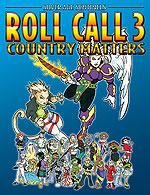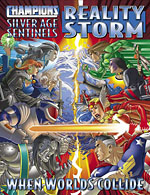By Jonathan Woodward
Oct 12, 2004
This month, I thought I'd offer some reviews. This should come as a shock to no one.
Kinda Plays Like an Angsty Teenage LiveJournal
Hearts Swords Flowers (Phile, through Magnum Opus, an imprint of Guardians of Order, for BESM, 96 undersized pages, softcover, black-and-white, $16.95) is only the second game I've seen that aims squarely for the shoujo anime genre. (Here's the five-second explanation of shoujo: two subgenres of manga (comics) in Japan are shonen, boys' literature, and shoujo, girls' literature. Shonen has giant robots and hot babes, shoujo has romance and hot guys. The division carries over into anime, since many anime are based on comics. Here endeth that lesson.) The other was HeartQuest from Seraphim Guard; this is the better of the two.
About three-quarters of this book is utterly generic, with nary a game mechanic in sight. It includes an overview of the genre from many different angles, a lengthy discussion of different character types found in shoujo, how to make good villains (hint: sexy ones cause more angst), assembling a campaign, sample campaigns, and, of course, info on cross-dressing, bisexuality, homosexuality, transgender transformations, comedic nudity, androgyny, and all the other things that make life worth living.
 |
Most of the material is very good, very systematic (though chapter 3 is a bit of a grab bag), and laden with examples. Unfortunately, most of the examples are taken from manga, so a lot of people are just not going to be familiar with them. Manga simply hasn't caught on over here as much as anime has. I'm more than usually up on Japanese culture, and I didn't recognize many names. Still, a dedicated shoujo-reader would have an easier time of it, and they're the target audience.
The heart of good romance drama, of course, is Not Getting What You Want. If you use this book in your campaigns, expect angst, sorrow, tears, and heartfelt declarations of love . . . especially once they start using the game mechanics. They allow players to specify and quantify their characters' Interests, Motivations, Drives, and Obsessions. These traits then grant focus points, which can be used like "hero points" or "drama points" to alter events, so long as the alteration is in tune with the Interest, Obsession, or what-have-you in question. It's not complicated, and easy to transport to systems other than BESM. It's also fairly abuseable, unless the GM keeps a tight rein on allowed Obsessions. "Defeat my enemies" should probably not be on the approved list . . . (Oh, and, once again, it seems "BESM" is meant to stand on its own as the name of the system. To find out what it stands for, you have to browse the copyright info, or wait until page 71.)
Editing is kinda iffy, with a mistake every few pages. Not to mention, at one point they refer to the book as "Hearts, Swords, and Flowers," when it clearly lacks both punctuation and conjunction on the cover and everywhere else. The art is mostly good, and definitely in the appropriate style, though the variations in tone from goofy to winsome to savage can be disconcerting. Layout is uncomplicated single-column-with-boxes, and the boxes are mostly used for bullet lists of genre hints; I approve. So, overall, this is the RPG sourcebook of choice for the shoujo genre (not that there's much competition), and moderately (verging on "strongly") recommended for anyone wanting to put romance and heartbreak into their games. If you prefer to blow things up, this ain't the book for you.
Either Way, Bad Title
My second Guardians of Order product this time 'round is Roll Call 3: Country Matters (for Silver Age Sentinels, with stats for both d20 and Tri-Stat d10, 32 pages, softcover, black-&-white, $9.95). This is a collection of female superhumans for the SAS setting. First, I'm going to rant about the title a bit. "Country matters," as a phrase, has been around for centuries, meaning the affairs of rural areas. It also appears in Hamlet, Act III, Scene 2:
 |
Hamlet: Lady, shall I lie in your lap?
Ophelia: No, my
lord.
Hamlet: I mean, my head upon your lap?
Ophelia:
Ay, my lord.
Hamlet: Do you think I meant country matters?
Ophelia:
I think nothing, my lord.
Hamlet: That's a fair thought to lie
between maids' legs.
Now, Shakespeare was not above a dirty pun or two. Being an uptight sort, I'm not gonna spell it out. But you gotta wonder if that particular pun is appropriate for a book of female characters. Maybe they meant it that way (in which case I wonder about their judgment), maybe they didn't (in which case they gotta work on their research). Either way, bad title.
(Oh, and their official stance is that the title refers to the fact that the characters are from various countries around the world, they didn't intend it to be a Shakespeare reference, the bit in Hamlet is really obscure, and Shakespeare didn't mean it that way, anyway. Ah-hmm.)
Anyway, apart from being female superhumans from around the world, all these characters also have some connection or other to the SAS villain Janus. Many of them are his former sidekicks (and Janus does, indeed, have Sidekick: Femme Fatale on his character sheet in the original SAS book). First off, there's a mechanical problem here. Janus bought Sidekick at the 1 point/level cost. This means he is limited to one specific sidekick; he can't change from one to another. The other problem is that he only has it at level 10, which limits him to a 50-point or 62-point sidekick (depending on the GM's choice of mechanics). Of the 24 characters in RC3, none of them have a total lower than 75, and most are much higher.
Then there's the "political correctness" problem. Yah, the superhero genre is male-dominated, so making a book of female characters (odd title aside) is a good thing. But then they went and made sure they were all connected to a manpulative, charming, seductive, evil man. I can't help thinking that was a poor choice. These fish shouldn't need a bicycle; why not let them exist in their own right?
Part of the answer to that question is that it's easier to write adventure seeds if the characters are already connected and, indeed, the half-dozen seeds at the back of the book are mostly quite good, especially "Cease to Exist." They benefit from everyone having Janus in common, but also suffer because, in at least two of them, the characters are acting in direct conflict with their stated opinions of Janus. This adds mystery -- why the change? -- but it also looks kinda sloppy. Less sloppy, but more odd, the book is divided into three sections (with faux-comic covers at the head of each) with no explanation of what distinguishes the three sections. (And, on p. 21, what's an "Ahl of Evil," anyway?)
Hmm, haven't actually talked about the characters yet, have I? In general, no complaints. They have a wide variety of powers, origins, and motivations. Many of them have been manipulated by Janus, but that's his shtick, after all. The writers do fall into the trap of giving 16 out of 24 the Features (Appearance ×1) attribute or better, indicating beauty -- even the severely autistic 13-year-old. (Of the eight who lack it, two have facial scars, two have tattoos, and one looks diseased.) Yeah, this is true to the genre, but repetitive and unimaginative. The game mechanics are generally good, though I found some errors. (For example, Myriad is a 198-point character, not 200. She also spent 4 points on Highly Skilled, then only used 2 of them. And those errors don't cancel out. Similarly, Black Annie has only spent 89 of the 100 skill points she paid for.)
In the "amusing typography" department, this is a d20 book, hence has open game content, and hence the title page explains that everything in the Helvetica font is open. This is moderately clever, and it means that, in the character sheets, they switch to a serif font for product identity like "Janus," "Empire City," and the names of special attacks. I honestly think it's a good way of doing things, though it must be murder on editorial.
 |
Speaking of which, the editing is quite good; I only noticed one typo, and one homonym mistake. (You only use "capitol" if you're talking about a building. Otherwise, "capital.") Some of the sentences are oddly put-together, but that might just be me. Layout is functional (tricky for a dual-statted book) but crowded (they switch to a teeny font for characters with both complex powers and long stories). The art in the book is mostly headshots for each character. They're a little too manga and not enough Kirby/Ditko/Infantino for the ostensible genre (it's Silver Age Sentinels, after all), and all look like rough pencil sketches. It's not a bad style, and many of them are quite pretty, but it definitely doesn't evoke comic books. The cover borders on yuck. The good side is that every character is portrayed consistently with her description in the text, and we get to see their full costumes. However, they're all done in a slightly super-deformed manga style (i.e., big heads, overly cute). None of them look impressive or menacing; they look like Smurf villains or (being as generous as I can) characters from the current Teen Titans TV show. In summation, RC3 is moderately recommended to people running SAS games or other modern superhero games, and not really recommended to anyone else. And, GOO? Please, change the title if you reprint it.
Damn, I have nowhere near enough room left to talk about Eberron, and I meant to review Poisoncraft too. (I'm also shy on time; I have to turn in the first draft of GURPS Banestorm in ten days.) Hope this is enough to tide you over, and I swear, I'll get to them next month.
Useful Links:
Want me to review your game? I'm delighted to accept review copies care of Blue Blood.
